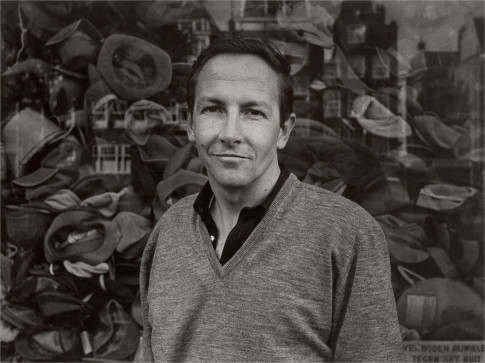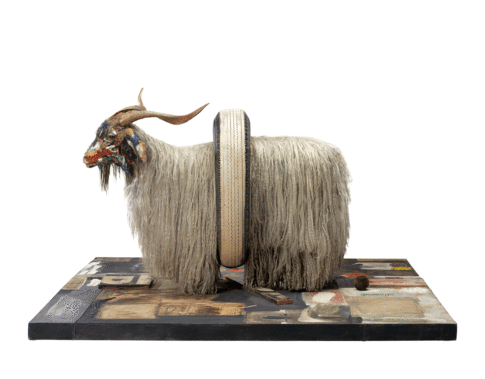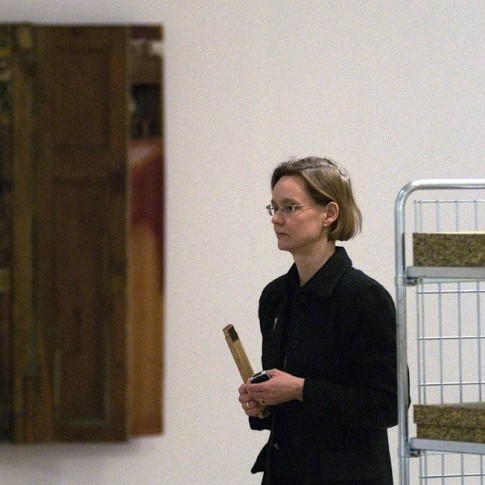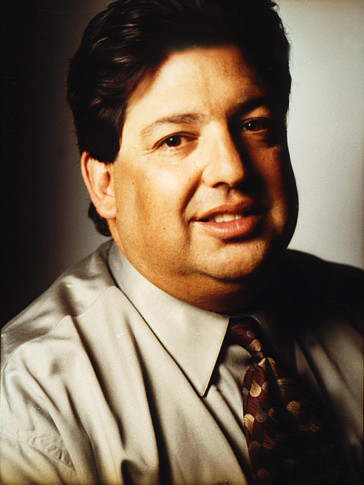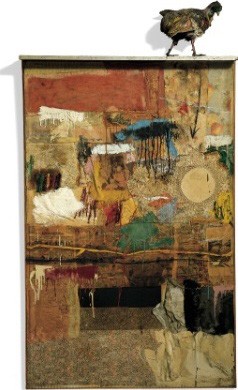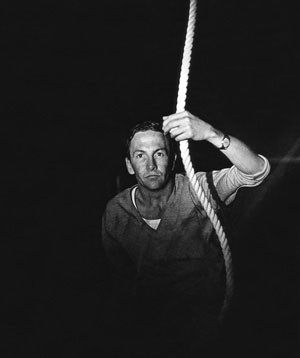
The image is from "5 New York Evenings" which was held at Moderna Museet in September 1964 Photo: Stig T Karlsson
Robert Rauschenberg and Moderna Museet
Rauschenberg created a new work especially for Movement in Art.The work, which he called Black Market, was commissioned by Billy Klüver (1927-2004), an engineer living in New York, an old friend of Hultén who had many friends in the American art scene. Black Market consists of a painting attached to a suitcase lying on the floor. The suitcase originally contained four rubber stamps and an inkpad. Black Market also featured in the Dream Museum exhibition in 1964 but was not included among the many works that were purchased for the collection with the SEK 5 million government grant at the time.
Rauschenberg came to Stockholm to install Black Market and offered to help install other works in the exhibition. During his time in Stockholm he also created another painting that was hung next to Black Market. According to an anecdote, Rauschenberg was walking next to a young woman at the opening who, on passing Rauschenberg’s work, commented that Ingemar Johansson (the boxing champion) could just as well have painted it. Consequently, Rauschenberg went up to his painting and wrote on it with a pen “This is Johanson’s Painting”, and that is the title of the painting to this day.
The following year, in 1962, Moderna Museet featured the exhibition 4 Americans: Jasper Johns, Alfred Leslie, Robert Rauschenberg, Richard Stankiewicz. This is also one of the more famous, debated and well-visited exhibitions in the museums first years. Pontus Hultén noted in the introduction to the catalogue that the greatest adventures in visual arts after the Second World War had taken place in America, and that Rauschenberg was the most renowned artist of his generation. There are even other similarities between the introduction dated 1962 and the postscript he wrote for the current catalogue. At the 1962 exhibition Rauschenberg presented 17 combines and two drawings. These included Charlene (1954), Odalisque (1955–58) and Pilgrim (1960). All these are now back at Moderna Museet. This was also the first time Monogram (1955–59) was here, and “The Goat” definitely stole the limelight in the reviews.
Two years later, in 1964, the museum and Fylkingen jointly organised five New York evenings with ballet, concerts and happenings. Stockholm was visited by the Merce Cunningham Dance Company with John Cage, David Tudor, Yvonne Rainer, Robert Morris and Robert Rauschenberg. Rauschenberg accompanied Cunningham’s company on a world tour, designing costumes, lighting and stage sets. At the time, he developed an interest in performance and created a new programme for his New York evening on 13 September, the now famous Elgin Tie. The artist slid down a rope from the museum ceiling and landed in a barrel of water, after which he followed a real cow out of the gallery. This performance was only carried out once.
In 1965 Robert Rauschenberg was again featured at Moderna Museet, with his illustrations for Dante’s Divine Comedy (The Inferno), presenting his interpretation of the literary work and also demonstrated his fascination for trying out new techniques and materials. Monogram was shown for the first time after its purchase in 1964, along with the drawings. Since then, it has featured in the museums permanent collection exhibitions and has been seen by generations of visitors to the museum. Rauschenberg returned to the museum again in 1973 to participate in The New York Collection exhibition. This project, which had been launched in 1971, was another collaboration between Klüver and Hultén. The idea was to gather a group of key works by artists who were active in New York in the 1960s. Together with several artists, Klüver had built up the organisation Experiments in Art and Technology (E.A.T.) during that period, with the purpose of combining art and technology. Together, they managed to get funding from the Ministry of Education to acquire some 30 works of art for the Moderna Museet collection, including Rauschenberg’s Mud Muse (1968–71).
In spring 1982, the museum organised an exhibition of photography by Robert Frank, Robert Rauschenberg and Andy Warhol. Lastly, Rauschenberg designed the fascinating cover for the Anniversary catalogue Moderna Museet 1958–1983 (1983). In early spring 2007, visitors to Moderna Museet will once again have an opportunity to experience Monogram in its own setting – together with other related works in the exhibition Robert Rauschenberg: Combines.

The images are from “5 New York Evenings” which was held at Moderna Museet in September 1964. Photo: Stig T Karlsson
Text by Anna Tellgren from the catalogue Robert Rauschenberg: Combines

